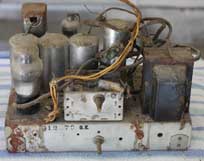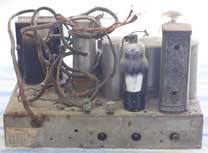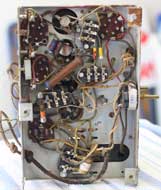![]()
Like a lot of people who collect stuff, I have a most-wanted list. For radios its relatively small; collecting old radios is a bit like collecting coffee tables: they take up a lot of room and storage quickly becomes a problem. It's definitely a problem for me, so I've had to pare down the list to the bare essentials. Here it is:
- Zenith Transoceanic — I have several. They're all tube-types and I wouldn't mind one solid-state job, but really I'm set for these.
- Zenith console — still on my wanted list, but I'm not actively looking because I absolutely have no place to keep it. But some day...
- Neutrodyne — got a nice 5-tube FADA.
- Hallicrafters shortwave — got an SX-42 that needs restoration.
- An old Wards Airline — got it. I worked for that outfit so there's a little irrational sentimental attachment.
- A Philco cathedral — it's an icon. Plus I always just liked that style.
Unfortunately, they're hideously expensive and I never see them for sale; typically I see the modern reproductions which I think are good looking but I don't want solid-state innards and I definitely don't want a cassette player on the side. I like the fact that they tried something different and updated a classic—but I don't want one.
.jpg) So instead I found this Model 84B. It's not the iconic cathedral, it's a bit more art deco and less gothic, but frankly I think that's a plus. It was expensive ($75)—the most I've paid for a radio to date (not counting car stereos), but it was attractively priced for what it is.
So instead I found this Model 84B. It's not the iconic cathedral, it's a bit more art deco and less gothic, but frankly I think that's a plus. It was expensive ($75)—the most I've paid for a radio to date (not counting car stereos), but it was attractively priced for what it is.
A couple bits of trivia that I thought were interesting: Philco called these the "Baby Grand" (as opposed to their big consoles, the "Concert Grands"). The cathedral name came later. Another is that supposedly the case design was a matter of clever engineering, because one piece of wood makes three-sides of the box.
According to Tuberadioland.com, this is the second cabinet style from 1935; the earlier cabinet front was circular; this is more scalloped. I like this one better.
Inside, this is definitely not another All-American 5. Actually it's an All-American 4.
Tube compliment
77 - Converter
77 - 2nd detector (there is no IF amp)
45 - Audio out
80 - rectifier
Also unlike the AC/DC sets I've been learning on, this one's got a transformer, and I've been warned to be extra careful because the voltages will make you light up and TILT like a pinball machine.
October 2, 2011: Haven't gotten it yet (it's in the mail) so I'll add to this page as things progress. Tube prices are all over the place. TubeDepot.com prices 77s at about $6 each, so I figure both of mine will be fine. The 45 and the 80, on the other hand, are more like $40 each (and more if you want the "globe" shape instead of the shouldered "ST" shape). The Old Man says the 80 is the likely one to be blown, and it can be replaced with a 5Y3 octal that's been coverted for the 4-prong base.
October 7: It arrived, packed in nearly its own body weight of bubble-wrap. For the initial inspection, the upside is that it's complete and in pretty good condition. The cabinet has some scratches and a couple of missing bits of veneer on the front, but it's basically sound—particularly the rounded sides. The front and the sides are supposed to be glued together and now it's not, so I'm going to have to do that before something breaks. But still—the knobs are there (don't know if they're original), the tubes are there, and so on. There's no back to it, but I figure I can cut something out of cardboard that will suffice.
The downside is that even though the outside looks pretty good, the inside looks like it spent most of its life in storage: everything's covered in an inch of dust and the cloth-covered wires are frayed and unravelling. I'll have to replace the AC cord at the very least.
Pulled the chassis, which (after the Bendix debacle) was easy. I blew out as much of the loose dust as I could and vacuumed up more. The photos are pre-cleanup, but to be honest the post-cleanup isn't much of an improvement. The main thing is that I'm missing one tube, but everything else is there and looks okay, especially the tuner caps: the fins are straight and it opens and closes nicely. There's a little crud on them, but hopefully not enough to matter.
October 8: Pulled the two tubes that I could easily get at, cleaned them and checked continuity across the filaments. Cleaned up the chassis as best I could but I can't do much with it. I'd have to completely disassemble it, including boring out the rivets, and it's all more work than its worth for my purposes and so many opportunities to really ruin things. On advice from The Old Man, I plugged it in to verify that all the tubes lit (they do, and the dial lamp), which means that the power transformer is okay and things are basically sound. Since I didn't have the rectifier tube, the filter caps won't charge so I won't get zapped (the filter caps are rated at 450v. The ones I've been dealing with up till now have been around 150v). That's about all I can do with this—I'm going to take it on the next visit and do it properly on the Old Man's bench.
That mainly leaves the cabinet. The side is pulling away from the front, so I ran a bead of carpenter's glue and re-set it. Also put on some Old English scratch cover on the sides, which helped tremendously. When it's fully dry, I'll put some on the front, and that'll hold it until we can finish off the chassis work.
November 25: Took it to The Old Man, and we looked it over. The workshop was freezing cold so we didn't do very much. Mostly we fired it up, hooked up the speaker properly, and verified that the stages work (though we did have to replace a cathode resistor that was too high). It's not picking up any stations but we did get a tone from the signal generator. So it's weak (the old man commented that it would take a lot of antenna to feed it). On my next visit we'll probably try to align it, and if not, see if we can determine where it's weak.
December 6, 2012: Yes, it spent nearly a year in The Old Man's garage. Time passed faster than I'd thought. I had moved, gotten a garage of my own and a workbench going, not just a folding table I could use when the roommate was out of town, so I was able to reclaim the radio and brought it home. Wiped some Howard's Restor-a-Finish and wax over the cabinet which spruced it up a bit. Not a lot but it does look better than it did.
Fired it up again with the idea of aligning it but got nothing but static. Couldn't get anything through the machine with the signal generator and I was beginning to wonder if the audio detector was dead. For some reason I'd stuck a whip antenna into the antenna clip on the chassis (probably when I was messing with the signal generator), and when I touched it I realized I was getting a signal. Held onto the whip and tuned around the dial and yup, it does work, it's just very weak. I could get three big stations.
So I attempted an alignment. The IF appeared to be already peaked. The regeneration control had no effect at all. One of the things you do on this is turn the regeneration (sensitivity) control until the audio starts to squeal, and then back off half a turn. The control turns out to be a variable capacitor. I haven't taken a serious look at it yet but I assume that's the problem. So next up I'm going to see if it's shorted out or bypassed or what-all.
Before someone emails me to tell me that I need a big outdoor antenna and a proper ground: I know. I'm working on that. Unfortunately it's on the list behind some other things that have to be done first. I bought a fixer-upper starter house and there's a lot of fixing to do.
But damn it, I'm getting there. Step by step, this thing is getting dragged closer to being something I could actually turn on and play in the house.
Current status: antenna coupling capacitor needs repair.




.jpg)